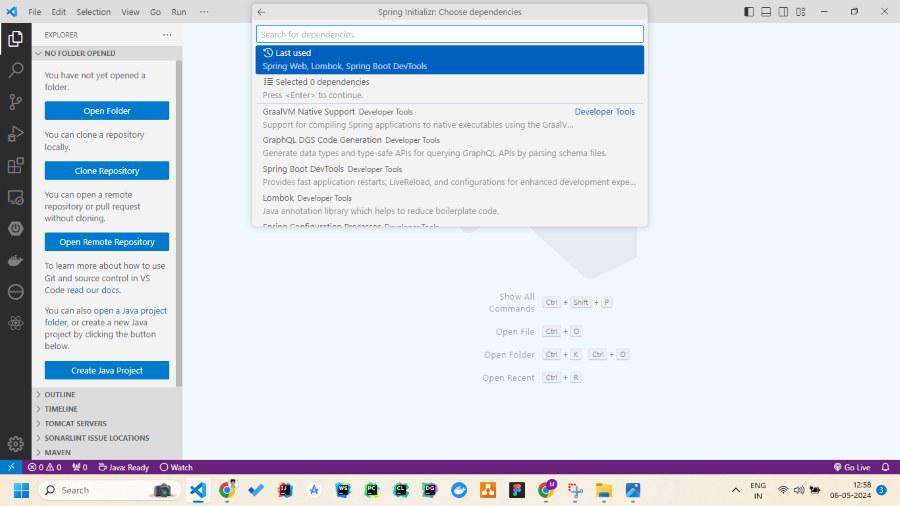How to Build Spring Boot Project in VSCode?
Last Updated :
20 May, 2024
Creating a Spring Boot project in Visual Studio Code (VS Code) streamlines the Java development experience. In this article, we'll explore the steps to set up and build a Spring Boot project in VS Code, ensuring a solid foundation to start developing robust applications.
Step by Step process to the Build a Spring Boot Project in VS Code
Step 1: Ensure that the Java Development Kit(JDK) is installed on the computer system and download and install the Visual Studio Code if not already installed.
Step 2: Install the Java Extension pack and Spring Initializer and Spring Development Tool extension of the VS Code.
Install the Spring Initializr Java Support extension in the VS Code.

Install the Spring Boot Tools extension in VS Code.

Install the Spring Boot Extension pack extension in VS Code.

Step 3: Now, we can open the VS Code and access the Command Palette using the shortcut(Ctrl+shift+P).
type "Spring Initializr: Generate a Maven Project" and enter it.

Step 4: We can choose the version of the Spring Boot application.

Step 5: We can enter the project metadata like the Group, Artifact, Name, Description of the Spring application.
Artifact Id:

Group Id:

Choose the language: Java

Select the Version of the Java

Step 6: We can select the required dependencies needed for the project.
Example: Spring Web, Lombok, Spring DevTools

Step 7: Finally, we can choose the location to the generate the project and click the Generate option to generate the Spring Project.

Step 8: We can open the generated project folder in the VS Code application.

Step 9: Open the main class the add the simple controller method of the Application.
Java
package com.example.demoexample;
import org.springframework.boot.SpringApplication;
import org.springframework.boot.autoconfigure.SpringBootApplication;
import org.springframework.web.bind.annotation.GetMapping;
import org.springframework.web.bind.annotation.RestController;
@SpringBootApplication
@RestController
public class DemoexampleApplication {
@GetMapping("/hello")
public String check() {
return "Hello World";
}
public static void main(String[] args) {
SpringApplication.run(DemoexampleApplication.class, args);
}
}
Step 10: We can run the application then it will start at port 8080.

Step 11: We can verify the application is running by the accessing the configuration the local server URL.
http://localhost:8080/hello
Output:

By the following the above steps, we can effectively setup, configure and run the Spring Boot project within the Visual Studio Code. It is leveraging its powerful features for the efficient Java development.
Similar Reads
Non-linear Components In electrical circuits, Non-linear Components are electronic devices that need an external power source to operate actively. Non-Linear Components are those that are changed with respect to the voltage and current. Elements that do not follow ohm's law are called Non-linear Components. Non-linear Co
11 min read
Spring Boot Tutorial Spring Boot is a Java framework that makes it easier to create and run Java applications. It simplifies the configuration and setup process, allowing developers to focus more on writing code for their applications. This Spring Boot Tutorial is a comprehensive guide that covers both basic and advance
10 min read
Class Diagram | Unified Modeling Language (UML) A UML class diagram is a visual tool that represents the structure of a system by showing its classes, attributes, methods, and the relationships between them. It helps everyone involved in a project—like developers and designers—understand how the system is organized and how its components interact
12 min read
Steady State Response In this article, we are going to discuss the steady-state response. We will see what is steady state response in Time domain analysis. We will then discuss some of the standard test signals used in finding the response of a response. We also discuss the first-order response for different signals. We
9 min read
Backpropagation in Neural Network Back Propagation is also known as "Backward Propagation of Errors" is a method used to train neural network . Its goal is to reduce the difference between the model’s predicted output and the actual output by adjusting the weights and biases in the network.It works iteratively to adjust weights and
9 min read
Polymorphism in Java Polymorphism in Java is one of the core concepts in object-oriented programming (OOP) that allows objects to behave differently based on their specific class type. The word polymorphism means having many forms, and it comes from the Greek words poly (many) and morph (forms), this means one entity ca
7 min read
3-Phase Inverter An inverter is a fundamental electrical device designed primarily for the conversion of direct current into alternating current . This versatile device , also known as a variable frequency drive , plays a vital role in a wide range of applications , including variable frequency drives and high power
13 min read
What is Vacuum Circuit Breaker? A vacuum circuit breaker is a type of breaker that utilizes a vacuum as the medium to extinguish electrical arcs. Within this circuit breaker, there is a vacuum interrupter that houses the stationary and mobile contacts in a permanently sealed enclosure. When the contacts are separated in a high vac
13 min read
AVL Tree Data Structure An AVL tree defined as a self-balancing Binary Search Tree (BST) where the difference between heights of left and right subtrees for any node cannot be more than one. The absolute difference between the heights of the left subtree and the right subtree for any node is known as the balance factor of
4 min read
CTE in SQL In SQL, a Common Table Expression (CTE) is an essential tool for simplifying complex queries and making them more readable. By defining temporary result sets that can be referenced multiple times, a CTE in SQL allows developers to break down complicated logic into manageable parts. CTEs help with hi
6 min read